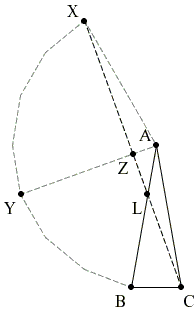The 80-80-20 Triangle Problem, A Derivative, Solution #3

ABC is an isosceles triangle with vertex angle
|Contact| |Front page| |Contents| |Geometry| |Up|
Copyright © 1996-2018 Alexander Bogomolny
The solution is based on embedding the diagram into a regular 18-gon.

Line CE appears to pass through vertex X of the 18-gon, with

Let Y be the vertex of the 18-gon, midway between X and C and Z the foot of the perpendicular from A to CX, i.e. the intersection of CX with AY. Since ΔACX is isosceles,

To see that this is so draw AM and consider two right triangles, ACZ and ACM. These are equal by ASA: they share side AC and both have 80° angles.
We conclude that indeed L coincides with E, from which
∠ECA = ∠LCA = ∠CAM = 10°.
And finally,
Reference
- R. Honsberger, Mathematical Chestnuts from Around the World, MAA, 2001, Ch 2.
|Contact| |Front page| |Contents| |Geometry| |Up|
Copyright © 1996-2018 Alexander Bogomolny
73582515
